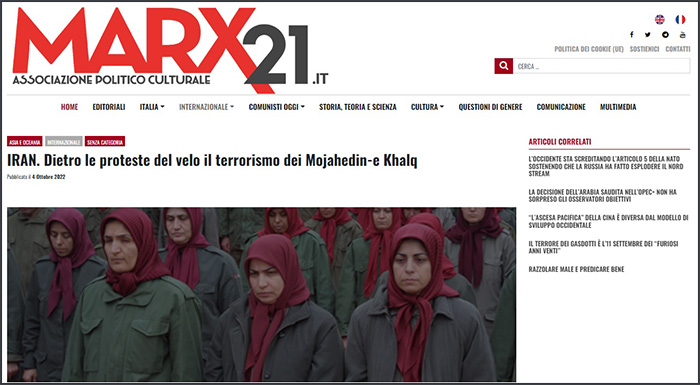The death of the young Kurdish girl Mahsa Amini, after being arrested for not wearing the veil correctly, sparked protests, demonstrations and exploitation. I do not want to discuss the legitimacy of these protests but I am struck by the news of October 1: The Iranian Ministry of Intelligence has presented a report according to which terrorist groups have incited the protests. According to news agency reports, 49 members of the Mojahedin-e-Khalq group, considered terrorist by Tehran and other states, were arrested, spreading propaganda to incite riots and providing incendiary material to demonstrators, following orders from members of the group in Albania.

The Italian Website Marx21: IRAN. Behind the protests of the veil, the terrorism of the Mojahedin-e Khalq
The Mojahedin-e Khalq (or Mojahedin of the Iranian People or Iranian National Liberation Army – PMOI, MEK, MKO) is accused of murdering about 12,000 Iranians in the last 40 years. The organization, founded in the 1960s by a group of radical students who profess Marxism and Islam, waged the first armed struggle against Shah Reza Pahlavi. After the Khomeinist revolution of 1979, the leader of the MEK, Masoud Rajavi, fights the fledgling Islamic Republic of Iran. In 1981, an attack by the MEK wipes out the leaders of the Islamic Republic: 70 officers killed, including President Mohammad-Ali Rajayee, Prime Minister Mohammad-Javad Bahonar and Chief Justice Hossein Beheshti. The Supreme Guide, Ali Khamenei, is seriously injured and loses the use of his right arm.
Later, the MEK summits took refuge in Paris, where they found their “political umbrella”, the National Council of Iranian Resistance (NCRI). In 1986, when President Mitterrand initiated a dialogue with Iran to release the French hostages held in Beirut, France expelled Masoud Rajavi. Meanwhile, the group – already deployed alongside the Iraqi army during the War against Iran (1980-1988) – flees to Iraq, supporting Saddam Hussein in suppressing the country’s Shiite and Kurdish communities.

Women at the MEK Camp Ashraf
Elizabeth Rubin of the New York Times in 2003 visits Camp Ashraf in Iraq (Diyala province) and is able to offer a description of the military base, organization and sectarian characteristics of the group. Rubin says she has seen “an artificial world of worker bees” – about half of the Mojahedin are women – and all, dressed in khaki uniforms and scarlet veils, practice the use of weapons, drive pick-ups and military vehicles. Since the 1980s, MEK adherents have had to take a vow of eternal celibacy, those who are married must divorce, those who are not must swear not to and cannot have children. Over the years the organization, although born from a Marxist-Islamist ideology, assumes the characteristics of a sect centered on the female role and the cult of the personality of the leader Maryam Rajavi (wife of Masoud): girls are taught that joining the sect is “A journey towards self-empowerment and the enlightenment of martyrdom inspired by the light and wisdom of Maryam Rajavi”. Thinking about the Ismaili sect of the Assassins is not really a coincidence!.
Since the 2003 US invasion of Iraq, the US neo-conservative-backed MEK has received training from the Joint Special Operation Command (JSOC) in the Nevada desert (communication techniques, cryptography, assault and guerrilla techniques, etc.). In 2012, testimony from two Obama administration officials denounced that the murders of five Iranian nuclear scientists (in 2007) were allegedly committed by the MEK in collaboration with Mossad and US intelligence support.
The US in September 2012 removed the MEK from the list of terrorist organizations – a list in which they were registered in 1997 by Secretary of State Madeleine Albright as an opening towards the reformist Iranian president Khatami -. The removal from the terrorist list is supported by Secretary of State Hillary Clinton who sends Congress a confidential communication on the matter, allowing the group to do business and activities under US jurisdiction. Since September 2012, the Mojahedin have left Camp Ashraf, their training and training center in Iraq, and are routed to Albania and Europe.
With the Trump administration and the appointment of senior officials such as Mike Pompeo and John Bolton, a new attempt is being made to destabilize Iran. This strategy envisages accreditation in Washington of the MEK group as a “legitimate opposition” to the Islamic Republic of Iran. There are several US political figures who seem “won over” to the cause of the MEK: the former mayor of New York, Rudy Giuliani during the annual MEK conference in Paris (June 2018) openly calls for regime change in Tehran; National Security Advisor John Bolton regularly attends their conventions. Moreover, lobbying efforts are well known in US politics.
Today the MEK publicly profess values of secularism and democracy in Iran, cheerfully exhibit a pro-free-market philosophy, preach women’s emancipation. However, within them they hide a contradictory truth, considering that the members of the group do not have access to newspapers, radio or television and that no one can criticize the leader. They also intend to overthrow the Iranian regime and create a government headed by Maryam Rajavi, already appointed by them as future president. Members are periodically subjected to self-criticism sessions in which they are filmed admitting to having behaved contrary to the laws of the group (the films can later be used against them).
Human Rights organizations have extensively documented abuses within the group, and the Iranian population itself does not recognize any legitimacy, indeed there is a profound hostility towards the MEK for the support provided to Saddam during the Iran-Iraq war.
Veil or not, it is difficult for Iranians and Iranians to forget the trail of blood left by the MEK.
By Marco Pondrelli, Marx21 – Translated by Nejat Society

